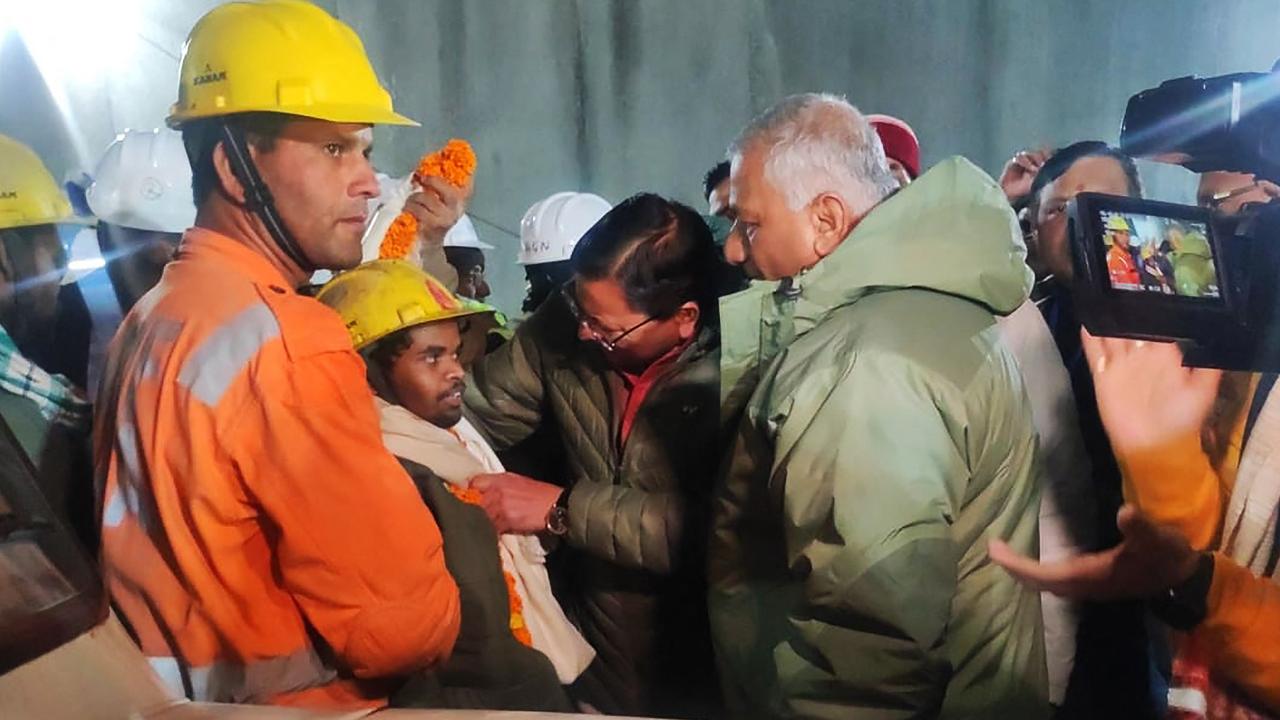Aussie saves trapped Indian tunnel workers after 17 days underground
All 41 workers trapped in a collapsed tunnel in India are alive and well after 17 agonising days underground, thanks to an Australian expert’s ingenuity and his team of rat-hole miners

READING LEVEL: RED
All 41 workers trapped in a collapsed Himalayan tunnel have been rescued after being stuck underground for 17 days.
Melbourne tunnel expert Professor Arnold Dix led a team of rescuers, including a group of “rat-hole miners”, in the delicate operation to free the workers after the underground tunnel they were working on in Uttarakhand, not far from India’s border with Tibet, collapsed after a landslide.
There were scenes of joy and relief as the trapped workers were brought out alive and well.
“Hail mother India!” crowds outside the tunnel cheered, as news spread that all had made it safely out of the collapsed tunnel.
Professor Dix, president of the International Tunnelling and Underground Space Association, said it was a delicate operation.
“It was nerve-racking – like, while this is happening, the roof – the mountain is ready to collapse. If we even had a little earth tremor it would come down,” he told Sunrise.
Prof Dix is being hailed as a hero for his work rescuing the trapped men.

HOW THE MEN WERE RESCUED
After trying to reach the men with multiple drilling machines that broke under the pressure of the rock, Prof Dix called in professional rat-hole miners to finish the last leg of the rescue.
Rat-hole mining is a primitive coal mining technique used in India, where narrow shafts that can only fit one person at a time are dug into the earth.
During the rescue, narrow tunnels were used to drop supplies to the men and to let oxygen into the space.

In the end, the rat-hole miners had to go down the pipe and dig the rock with hand tools “100mm at a time” in order to inch their way closer to the trapped workers, Prof Dix told Sunrise.
He said the ground was so unstable that rescuers could see the rock moving as they worked.
“We knew that if we did ruffle the ground any more, it would collapse and it would all be over,” he said.
Despite the challenges, Prof Dix and the team didn’t stop trying.
“We were all committed that we were going to get them home,” he said.
The rescue followed the laying of a final section of pipe that allowed the men to be pulled out. One by one, they passed through the 57m length of steel pipe on stretchers specially fitted with wheels, before being reunited with their families.
India’s Prime Minister Narendra Modi said the rescue had made “everyone emotional”.
“I want to say to the friends who were trapped in the tunnel that your courage and patience is inspiring everyone. I wish you all well and good health,” he said in a statement.
Prof Dix said the rescue was a joyful event in a world where many troubling things were happening.
“Here is a disaster where everyone is being nice,” he said. “We all helped each other.”
POLL
GLOSSARY
- primitive: basic
EXTRA READING
Solo rower’s incredible survival and homecoming adventure
Miracle rescue of cable car kids
Olympic hero saves four teens
QUICK QUIZ
1. How long had the workers been trapped underground?
2. In which country did the rescue occur?
3. What is the name of the primitive technique that was used in the final stage of the rescue?
4. What made the rescue dangerous and challenging?
5. How long was the steel pipe that led the trapped workers to safety?
LISTEN TO THIS STORY
CLASSROOM ACTIVITIES
1. Write the rules
Professor Dix is the president of the International Tunnelling and Space Association. Who do you think should be allowed to join the association? Write a list of rules for joining. Include skills, particular jobs, qualifications and other rules that people wanting to join should have or follow.
Time: allow at least 20 minutes to complete this activity
Curriculum Links: English, Science
2. Extension
This is an amazing and inspiring story. Choose what you think is the most amazing or inspiring part. Use information in the story, your own ideas and maybe your research skills to write extra paragraphs for the story that focuses on the part that you have chosen.
Time: allow at least 40 minutes to complete this activity
Curriculum Links: English, Health and Physical Education, Science, Personal and Social Capability
VCOP ACTIVITY
Read this!
A headline on an article – or a title on your text – should capture the attention of the audience, telling them to read this now. So choosing the perfect words for a headline or title is very important.
Create three new headlines for the events that took place in this article. Remember, what you write and how you write it will set the pace for the whole text, so make sure it matches.
Read out your headlines to a partner and discuss what the article will be about based on the headline you created. Discuss the tone and mood you set in just your few, short words. Does it do the article justice? Will it capture the audience’s attention the way you hoped? Would you want to read more?
Consider how a headline or title is similar to using short, sharp sentences throughout your text. They can be just as important as complex ones. Go through the last text you wrote and highlight any short, sharp sentences that capture the audience.

